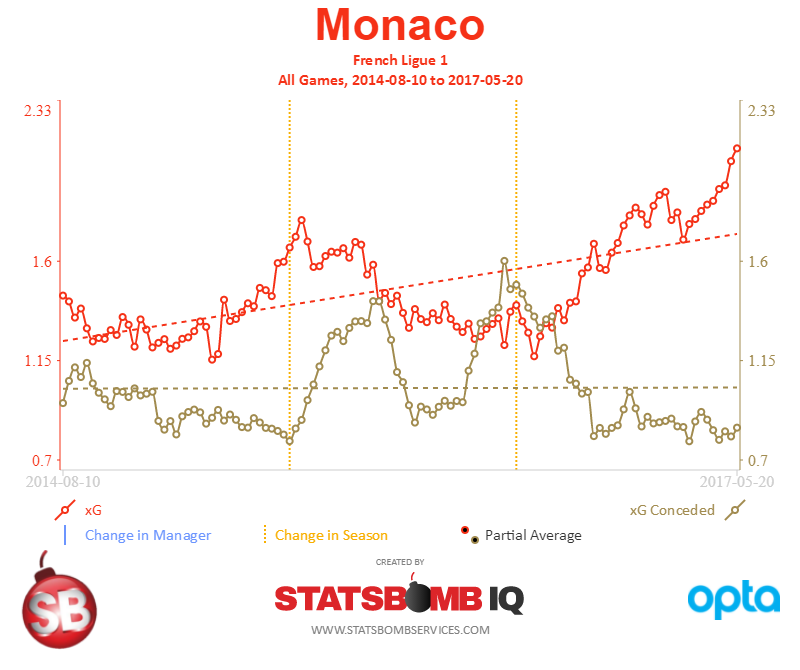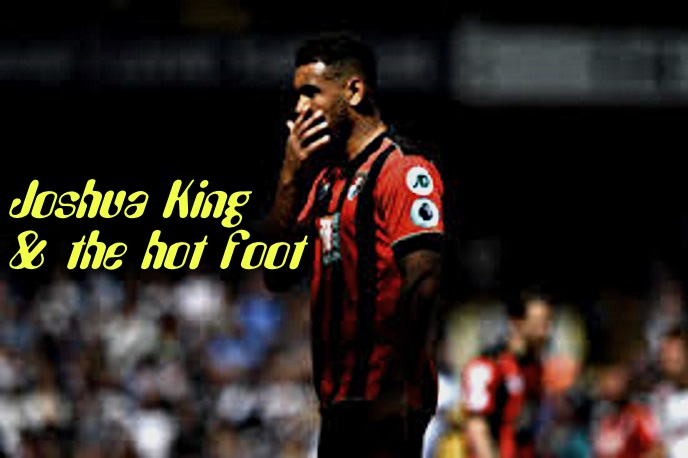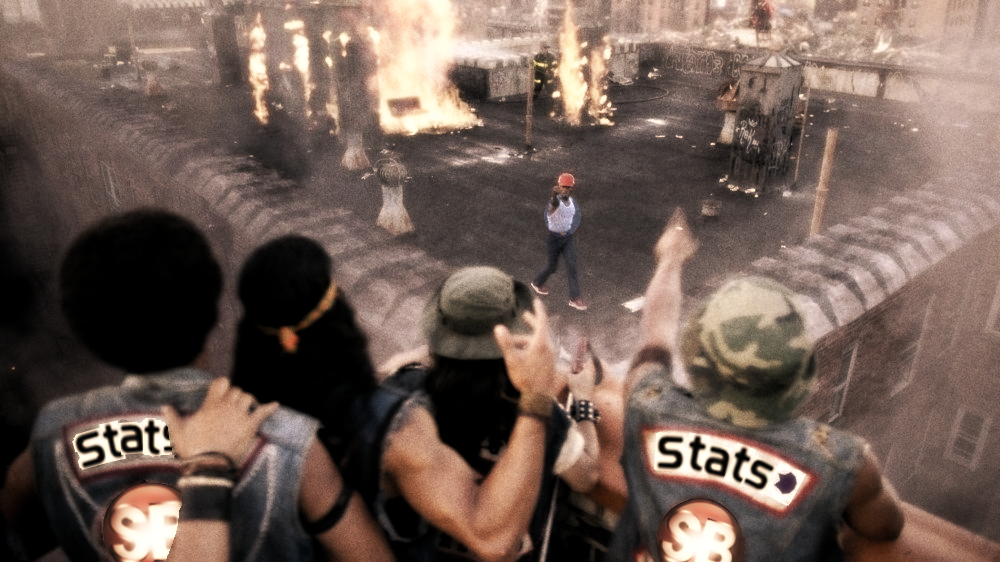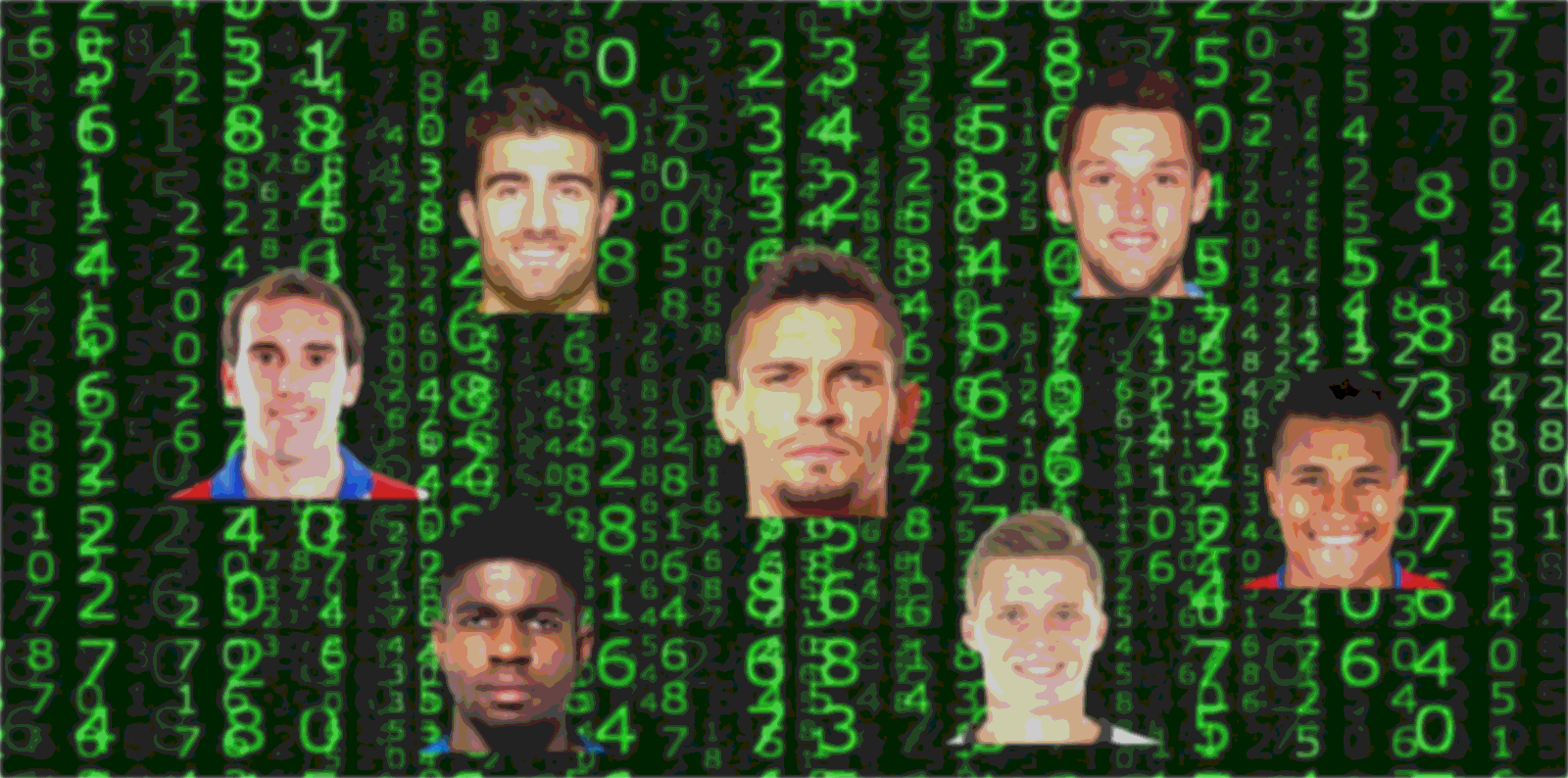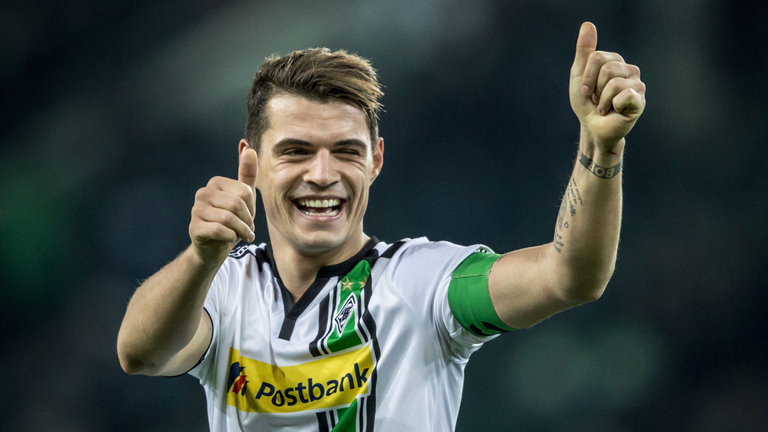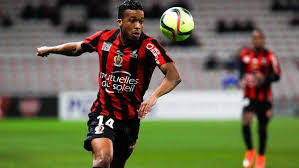Month: July 2017
Trend-ing Topics. How Basic Data Vis Can Reveal Incredibly Important Football Info
One of the things we’ve been doing with StatsBomb IQ since we started is incorporating almost all the analysis tools that we use on a regular basis for teams and players into a simple, attractive interface.
Want to pull up radars of every player across your entire data set? We can do that.
Want shot maps with active filters for 34+ leagues? Already done.
A guided wizard that helps you choose your own metrics, including xGBuildup and our passing ability score, to find the best players to scout? It’s called IQ Scout and we released that early in the summer.
The new vis set we’re releasing this week is actually one of the simpler ones we’ve done but also one of the more powerful: trend lines. The wow factor here is less about the vis itself, but more about what you can do with them and why they are incredibly important.
Why Do I Care? 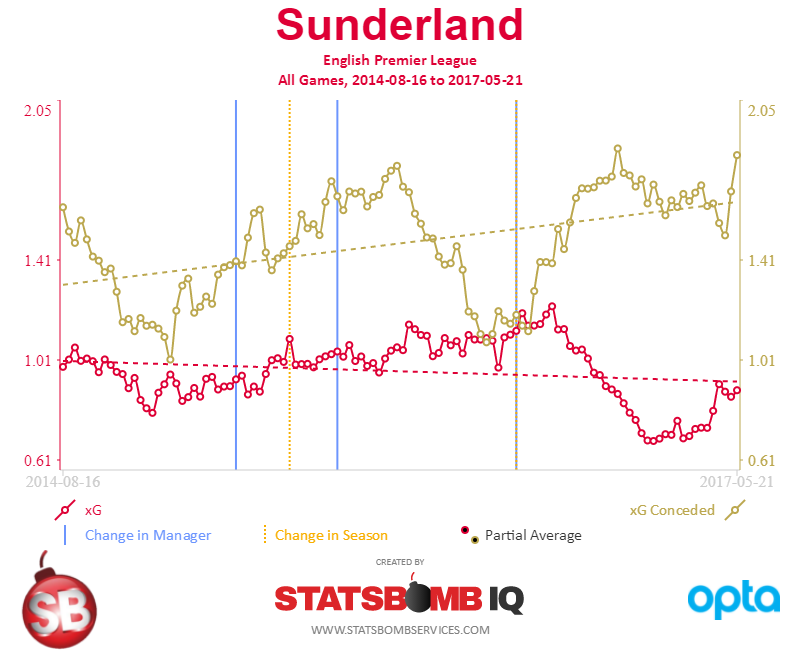 What you see above is Sunderland’s 3-year trend, with 15-game rolling averages. xG in attack is red and xG conceded is in gold.
What you see above is Sunderland’s 3-year trend, with 15-game rolling averages. xG in attack is red and xG conceded is in gold.
Why expected goals (or xG)? Because xG Difference is one of the stronger metrics in the public sphere for predicting future performance. There are plenty of other potential metrics to plot, and we will be incorporating them gradually, but at the team level xGD is something we really care about.
Plotting attack and defense here also gives you an idea of how the team is doing in each aspect of the game.
Now if you manage or own a football club, you want this information. You need this information. This information is one of the clearest indicators of how your club is performing currently and the long-term trending of team output. If I were Ellis Short (or Chief Football Officer Simon Wilson) looking at my team trends, I breathe a huge sigh of relief that Sam Allardyce finally managed to stabilise the team after years of teetering on the brink of relegation.
Then Allardyce goes to England and they need to find a new manager. On the surface, Moyes is a perfectly sensible hire. He speaks the language, knows the league, and did a great job at Everton.
Then you watch the trending and concern sets in. By mid-October, I would be worried that there is a problem. By late November, it’s clear that all the good work that Allardyce had done has been unwound. Our results haven’t been “unlucky” – we deserve to be at or near the bottom of the table. I am almost certainly looking for a new manager because it’s now clear that, if we perform like we have the rest of the season, we’re strongly likely to get relegated.
Sunderland were interesting because of the massive change in team performance compared to every other manager they had previously, but think about bad teams that had lucky starts in recent years that were clearly relegation candidates in the numbers. Paul Lambert’s horrible extension at Aston Villa comes to mind, as does the initial start of Hull under Mike Phelan. Making change early to avoid disaster, or reviewing objective data before extending a coach on a "lucky" run can save teams tens of millions of pounds.
Single game results can certainly be lucky. Long-term trends make real performance of the team much more obvious.
Meeting Team Goals
Obviously you care about this type of thing to make sure you aren’t getting relegated from the Premier League, but what about teams with clear aspirations, like clubs that have been recently relegated and are looking at automatic promotion?
Now we know that in order to try and guarantee promotion from the Championship, teams need to average a .75 xGD or better over the course of a season. Teams can and do go up with less, but if you are a yo-yo club that wants to make certain you go right back up, this is the goal you are aiming for.
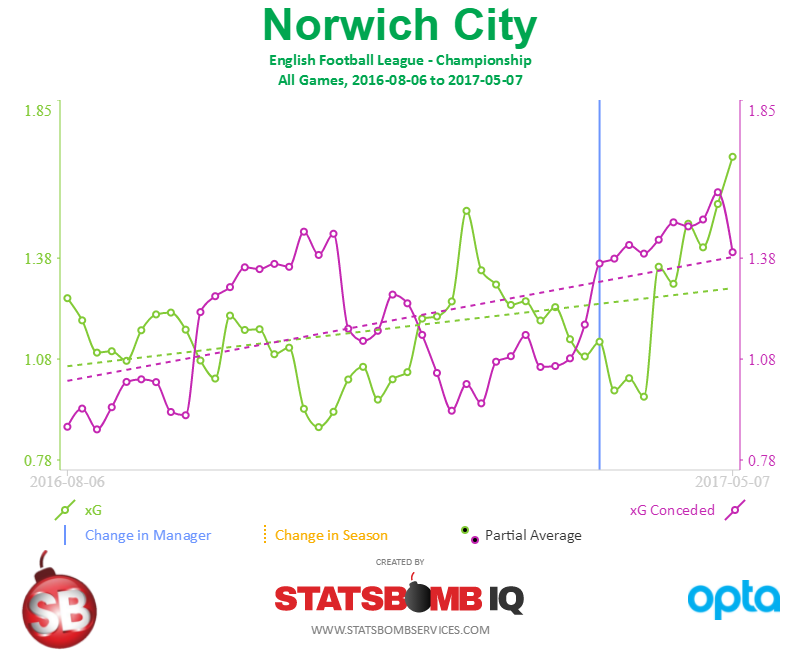
This is Norwich City last season, on a 10-game rolling average. It’s clear at the ten-game mark that the performance isn’t really meeting the goals for the season and suddenly automatic promotion might be a long shot. That doesn’t mean you have to change head coach at that point, but you certainly want to take a closer look to figure out what the problems are and how to fix it. Though fairly basic, this type of information is crucial in running a football club.
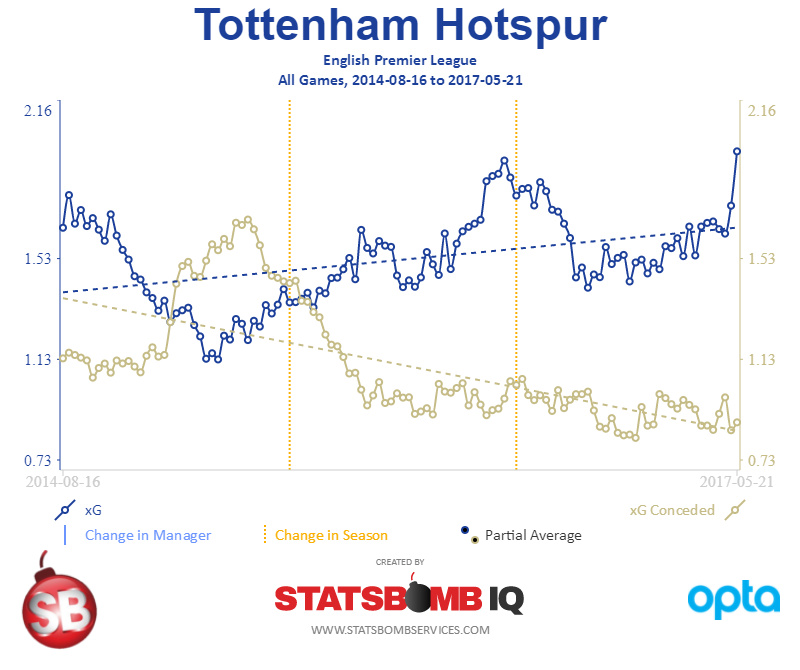
Tottenham
What you see above is a 36-month plot of expected goals in attack (blue) and conceded (gold) with a 15-game rolling average to smooth everything out.
What’s interesting with Spurs is that this plot shows a) how rough that first season under Pochettino was – they were actually negative for a while in xGD, and the press was shambolic – and also how good they have been since. Poch’s teams seem to have a tendency to outperform normal xG metrics as it is, but even with that caveat, the trending is quite clear here.
Want to see just home or away performances? We’ve added easy filters for that as well.
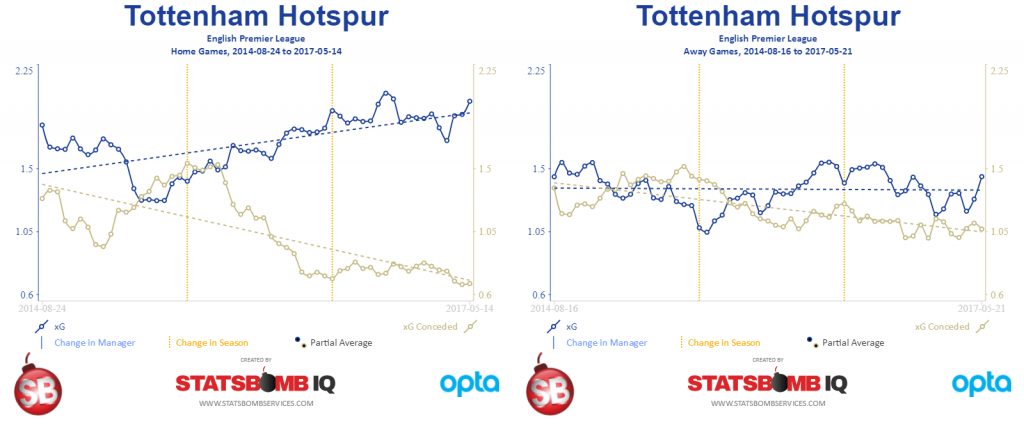
Arsenal
There are so many interesting storylines around Arsenal in the last year, it’s almost hard to know where to start.
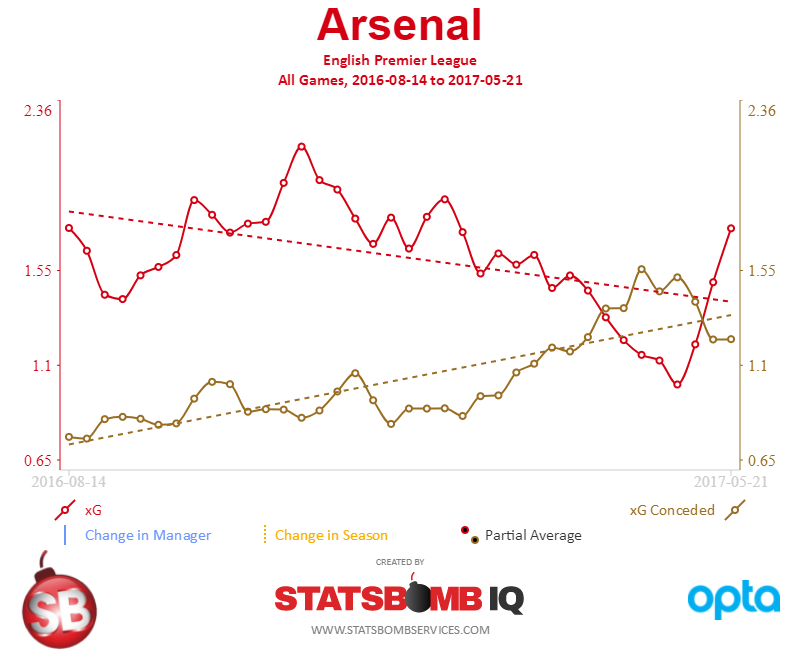
Here’s the one-year plot with 10-game rolling averages. Note the point where xG conceded actually ends up above xG in attack. In most big clubs, that’s a strong indicator that manager change is coming, but Arsenal is Arsenal and Wenger is back for another two seasons. I’m not saying he doesn’t deserve to stay – I’m just pointing out what happens almost everywhere else.
That particular dip in the trend is also interesting because it doesn’t exist in the previous 36 months and it coincides with the early part of the switch to a back 3. From an xG perspective, Arsenal’s April and early May was one of the worst in the data set. They were absolutely clubbed by Spurs and Palace, Boro lost but 55% of the time they win that one, and then Leicester and Man United were virtual standstills. The trend shot upward from late season trouncings of Sunderland, Stoke, and Everton, but despite a lot of spending recently, Arsenal look far from the ranks of an elite team.
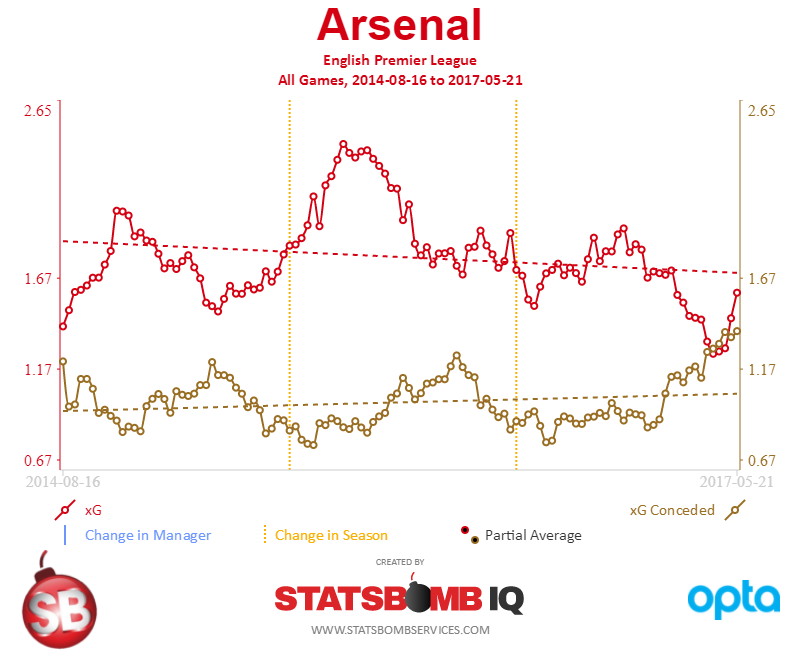
Non-xG Trends
There are plenty of stats in football you might want to track, but the vis below shows one I think certain head coaches care about deeply.
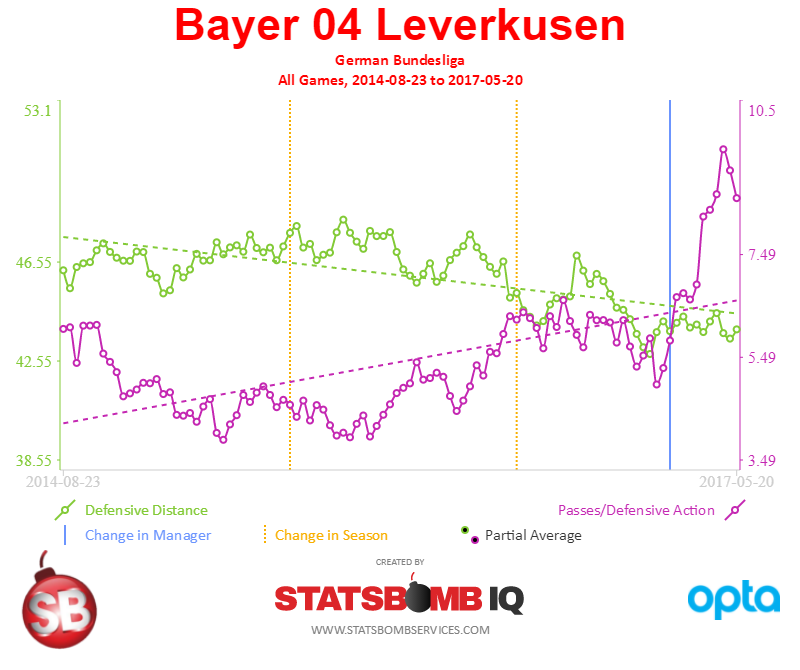
The green line here is Defensive Distance, the purple one is Passes Per Defensive Action or PPDA. Both of these combine to make a fairly robust look at team pressing, which for some coaches is the lifeblood of both their attack and defense.
This is Bayer Leverkusen's output over the last three seasons, most of which was under Roger Schmidt. It's interesting to contrast the output of the first two seasons where they finished in Champions League places, and the final season where results went south and Schmidt eventually left.
At a coaching level, this provides a very clear data indicator of what is or is not working to use alongside your own eyes, which in turn probably helps dictate the agenda for what to work on in training. This is pure game model analysis. Data informed coaching is a useful next step in football tactics, and trend lines help in surfacing problems quickly. [Vis Note: Yes, there are two different Y-axes here. For good reason. Deal with it, Luke Bornn.]
Conclusion Trend lines aren't groundbreaking visualizations, but they are one of the most useful, powerful ways of displaying recent team performance across a wide array of metrics. If you run a football club and don't have access to this sort of information at your fingertips, you are missing an important piece of information on which to base decisions.
--Ted Knutson ted@statsbombservices.com @mixedknuts
[Credit note: Nat James, who did the early mockups for radars, did the programming and most of the design work on the trend lines vis. They will be available to StatsBomb IQ customers starting tomorrow.]
Joshua King and the Hot Foot
Joshua King scored sixteen goals in the Premier League last season for Bournemouth. His contributions went a huge way towards securing their 9th placed finish. He has now been linked with a big money move and a fee of around £30m is being suggested.
Playing in various attacking midfield or forward roles, the 2016/17 season was a big step forward for King, after having taken time to find his feet since leaving Manchester United's youth system in 2013. A spell at Blackburn enabled him to play first team football and led to his move to Bournemouth in time for their arrival in the Premier League. Now 25 years old, he will feel he has made his mark, and a move back up the ladder would represent a huge step. But beyond the headline number of the 16 goals, is there anything else we can glean if we analyse his output. Should clubs be taking a chance on him repeating this form, or should they be more circumspect and hold fire? Let's take a look.
Conversion
First thing to note is King took three penalties last season and scored twice. This means for analysis purposes, he scored 14 non-penalty goals. The top line here is that those 14 goals came from 64 shots, the majority of which were with his right foot (44). That represents a conversion rate of over 20% which is on the high side compared to a league average of all shots nearer to 10% and in the knowledge that even prolific strikers rarely land over around 17% on a long term basis; the poacher type such as Miroslav Klose may well get higher. He only took six headed shots from which he did not score, so all his threat came from shots with his feet.
As a starting point for analysis, that high conversion rate looks like a hot goalscoring season that may contain elements that are unlikely to intrinsically recur. But in the first instance, that's just a presumption. Can we identify whether his season was more of an Aaron Ramsey 2013-14 (10 goals from 50 shots, has not repeated) or something more apparently sustainable like Luis Suarez (has converted his shots at a rate of 17% (Liverpool), 21%, 24% and 28% over the last four seasons)?
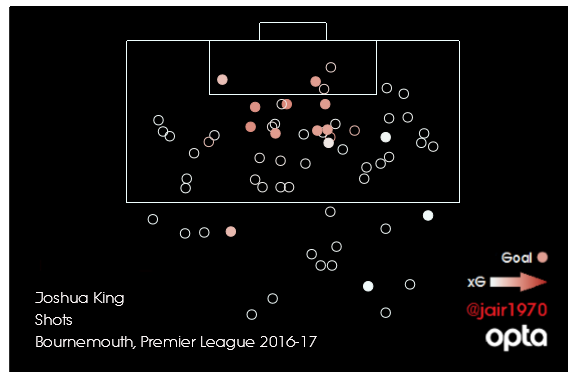
Now goals are only one aspect of King's play, but it's the headline act and the primary reason he is attracting wider interest. The next logical step here is to take a look at his expected goals. The top line is that he scored 14 goals from an expected rate of 8.6. So here we have some confirmation that the insight gained from his goals to shots rate is supported by adding in locational factors (and more). That discrepancy in itself does not offer us insight into how his goals occurred or whether the simple overshooting of expectancy is a product of skill or luck. Plenty of other players overshoot estimations, and do so every season.
During the last four seasons in the Premier League there are 564 instances of a player recording twenty or more non-headed shots in a single season. On a per shot basis, Josh King’s 2016-17 season ranked 14th of 282 that were overperforming goal expectation, so very much at the high end.
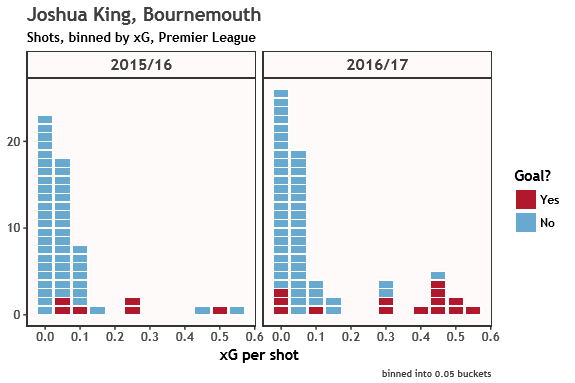
What can we deduce here? Firstly, in 2016-17 he scored three goals from 26 shots with an expected goal value of below 0.05. This can happen, but logically isn’t something that you might presume will continue. When shots with an estimation of one in twenty are going in at a rate of one in eight, it’s far enough out to be notable. Saying that, he was one for 25 in the 0.05 to 0.20 range which means for the entire low probability range he scored four times rather than an expected three. This is well within the realm of normal expectation and considering he went 3/50 in 2015-16 on similar shots, also shows some consistency.
Big and bigger chances
The real action comes from the higher end. Everything from 0.30 upwards here is a designated “big chance” and King holds an apparently impressive record of having scored ten from thirteen attempts (77%). However, this positive return can be tempered by looking at a comparison. Within the Premier League over the last four seasons, there are twenty occurrences of players scoring ten or more non-penalty big chances within a given season. No other player has recorded a conversion rate higher than 71.4%. Conversion rates notoriously fluctuate and King is away and clear at the top end of positive variance.
We can bounce it out to the big five European leagues over the same period, and we find his season ranks 2nd highest of 117 players on a per shot basis (behind only Gareth Bale in 2015-16, who converted 11 of 13 big chances). King may be keeping good company, but the overriding likelihood is that he has enjoyed a hot streak. Over a larger sample, no player finishes above a rate in the his fifties (Alexis Sanchez is on 57.5% on 73 attempts), so when we add in 2015-16, King remains significantly on the high side:
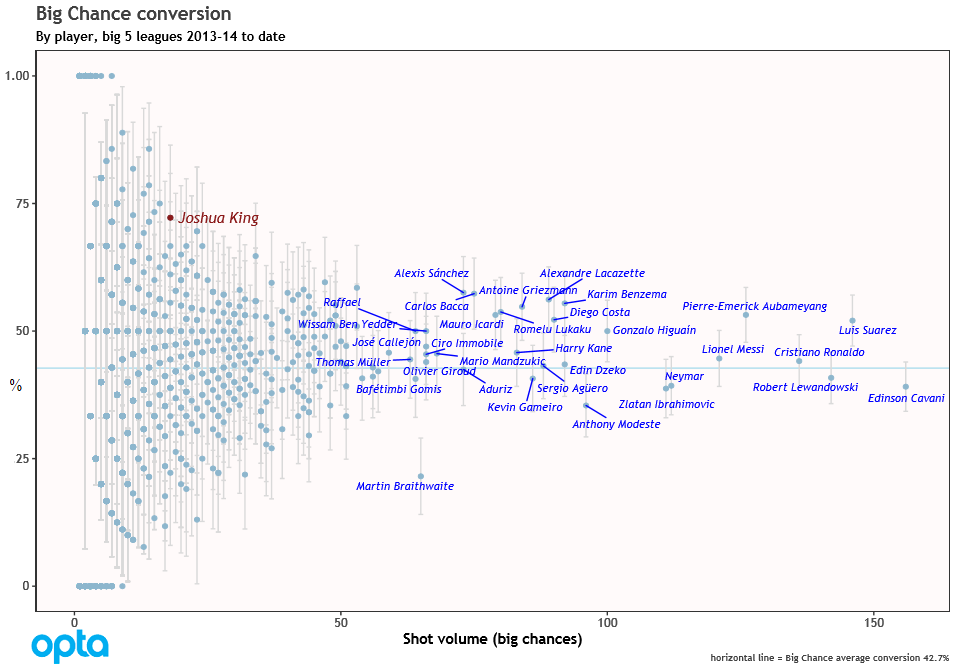
The idea that his goalscoring run is most likely a streak is enhanced when we split the season. Prior to New Year’s Eve, King played 1206 minutes in the league yet acquired just two big chances, both of which he missed. Between New Year’s Eve and the end of the season, he played 1505 minutes and was credited with eleven big chances of which he scored ten, the only miss coming from a left footed shot from a through ball against Middlesbrough. Can King continue to gain high quality chances at this new rate? That’s hard to answer, but over time his ability to finish them will surely reduce.
Positions and other factors
Positionally, the most identifiable change in King’s game came with a consistency of his role becoming central as his scoring run started. Before Christmas he spent time on the right of Bournemouth’s attack, a couple of games on the left and was a substitute on a handful of occasions, as well as time spent at centre forward and a support striker. This move into a pure central role, be it alongside or behind another forward did have an impact on his shooting volume, raising it from 1.5 per 90 minutes played to 2.5, of which as we’ve discussed, a high prevalence of better quality chances enhanced his expected goal rate (latterly 0.4 per 90).
The same before/after split sees an increase in his volume of key passes, from around 0.7 per 90 up to 1.2 after although this flattens to around one per 90 when he is playing centrally apportioned across the whole season. This is a low total, particularly considering his supporting role, and within Bournemouth’s overall 12 shot per game average. He is quite adept with the ball at his feet, and his 2.5 successful dribbles per 90 is on the high side for a central attacking player.
Difficult comparison
This blend of a not very creative running central player is intriguing and uncommonly recreated in the data. Indeed looking for comparative types throws up a variety of decent quality but mainly wide players in their younger seasons, Jordan and Andre Ayew in France, Riyad Mahrez in the Championship. Loosen off the dribbles category and we find 2015 brand Marouane Fellaini (!?). His pass volume of around 20 per game is on the low side for an attacking midfielder and within normal limits for an out and out striker. Should he remain at Bournemouth, and become paired with the notoriously ball-shy Jermain Defoe (whose active ball involvement is fairly similar to Callum Wilson), their attack will remain focused on a midfield that provides for their finishers.
The chief question remains: does 2017 Joshua King profile as a player that could enhance better teams? Is he worth a £30million fee?
Looking at his statistical profile, the goals total from 2016-17 sticks out like a sore thumb in comparison to other factors. There are slight upticks in other areas (shot creation, shots) during 2017, but they don’t appear to diverge significantly from the outputs generated before becoming a core and central player for Bournemouth. Indeed had he replicated the outputs of his 2015-16 season; six goals, two assists, any discussion about his prevailing quality would be moot. On balance, it’s probably correct to presume that 2017-18 will see King continue to be a solid contributor to Bournemouth but not to hit the goal heights of 2016-17. Should this transpire, the idea of £30m bids will wane, and whoever has then become flavour of the month can undergo the same analysis.
Why?
The purpose of this analysis was to give an indication of how much can be done, from nothing more than by simply delving into data. Without recourse to video or sending scouts out, plenty can be learned about the stylistic qualities and trends in a player’s profile. Alongside those analyses, this kind of dissection can and indeed should be performed way in advance of considering bidding for a player. It makes huge sense for clubs to be employing people to do exactly that with a view to enhancing their knowledge ahead of making purchases. Smart clubs will be going much further than this and building player models that mean data for analysis is on tap, visualising player outputs and matching them against their own club’s needs. Multiple leagues can be covered and good practice refined and improved upon.
King represents a relatively simple case for analysis as his goal total has raised his profile, yet is highly likely to be unsustainable. Does that mean signing him would be a mistake? Not necessarily, but it’s imperative that balancing realistic expectation against a large fee and a team’s needs creates a scenario where a club knows what it is getting for its money as far as can be reasonably deduced. With the transfer market inflating and the scope of common sense being employed proving to be hugely variable, the volume of preparatory work put into a transfer should cover all possible eventualities. Errors will never be eliminated entirely, but minimising them should be a primary target. What was a £10million mistake two or three years ago is now likely to cost multiples of that. Football would be well served in spending comparatively small fractions on smart practices to help them. _______________________________________
StatsBomb Podcast: July 2017, TRANSFERS!
[soundcloud url="https://api.soundcloud.com/tracks/332848108" params="auto_play=false&hide_related=false&show_comments=true&show_user=true&show_reposts=false&visual=true" width="100%" height="450" iframe="true" /] Transfer season is in full swing and Ted Knutson and James Yorke toss around some of the deals done and in the pipeline. Downloadable on the soundcloud link and also available on iTunes, subscribe HERE Thanks!
How do you scout for centre-backs statistically?
The centre-back market is one of the hottest around this transfer window. Chelsea have been linked with every big name going, City are apparently quietly interested in similar players, and Liverpool are trying their damndest not to mess up again after Klopp sent some dodgy Snapchats to Virgil van Dijk, or something. The question which I'm sure is on your lips is 'how do you scout central defenders statistically?'.
Well, you could ask Ted Knutson- but his methods are probably [redacted]. So I'll take you through a method of my own. These are ideas that I have worked on and considered over time, so it's not just plucked from the sky.
For centre-backs, the best thing to do is to whittle down the list by looking for stylistically similar players, and go from there. You can look at quality further down the line, probably with conventional scouting, as it's very hard (perhaps close to not possible at the present time) to assess pure defensive quality in single players through the stats.
I have four basic defending things that I look at.
- Activity: Literally how much they do per 90 minutes
- Depth: How high up the pitch they do stuff, calculated by taking the percentage of their actions above a certain point and subtracting the percentage of their actions that they do below a certain other point. The resulting numbers don't mean much as numbers, but the information they give is meaningful
- Front foot: How 'front foot'/proactive, versus how 'back foot'/reactive a defender is. Tackles and interceptions versus ball recoveries and blocks.
- Fail %: Missed tackles and fouls. Semantically, I prefer looking at the amount of times a player fails than calling all tackles and interceptions 'successes'.
I'm sure you're all desperate to get on with the scouting. For the purposes of this we'll work on the assumption that Liverpool are looking around for alternative signings to Virgil van Dijk. Based on Dejan Lovren and Joel Matip's stats for this season, Liverpool would ideally want someone who can play in a pretty high line, although with a pretty balanced front-back foot balance. They do a fair amount of sweeping up, but still need to know how to squeeze the space between midfield and defensive lines.
As a starting point, it makes sense to look for similar players against the Activity, Depth, and Front Foot categories. Fail % is a messy area as it's partly dependent on other stylistic matters, but too high a percentage can be used as a red flag.
Matip and Lovren profiled marginally differently in 2016/17, but Lovren - with some worse passing and higher Fail % (partly a result of style, partly an inherent trait of his) - probably has a little more scope to improve upon.
Depth and Front Foot numbers are probably marginally more meaningful for Liverpool than Activity, as whoever they buy will be left with the scraps that the midfield fails to mop up, whereas the other two are more directly related to how the defenders will play. Therefore, these two categories, and any particularly high Fail percentages, can be used to start whittling down names. A couple of untouchables like David Alaba (whose stats will be affected by his time at other positions anyway) and Samuel Umtiti can be struck off too.
However, Liverpool's stylistic requirements are so specific that - when scouting by the data - there aren't many similar options. Players in the Big 4 European leagues who don't have any strong stylistic flags against them, or who have one which is balanced out by a particularly strong similarity, are below.
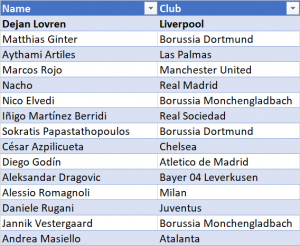
There are several names on there who should maybe have joined the 'untouchables' list earlier (Godin, Azpilicueta, Rugani, Romagnoli, Sokratis). At a push there's a slight chance that Liverpool might be able to tempt them over, but it's pretty unlikely. Maybe. Marcos Rojo you can cross off for 'Manchester United' based reasons. Aythami Artiles and Andrea Masiello, while some of the more interesting options, are both 31, so can be disposed of.
Let's alter the similarity parameters slightly to get a few more names. Passing, both in overall percentages and in terms of how much players advance the ball towards goal, are important for Liverpool and can come in. How Front Foot a prospective signing plays is probably more likely to translate to Liverpool than their Depth - a deep-lying player can be moved up the pitch, but an overly back foot player is harder to change - so Depth can go out.
And whaddya know, a certain tall, saintly, South Coast-based Dutchman appears on this list, although the most similar players are still ones at larger clubs. This is slightly less fun for an article on data scouting, but makes sense stylistically - smaller clubs tend not to play in a similar way to Liverpool. Taking the old guys and the likely untouchables off the previous list and replacing them with a small handful of more likely candidates, we get the below:
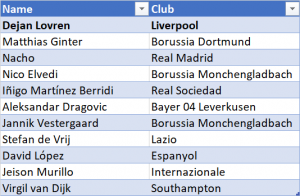
David Lopez probably deserves an asterisk by his name given that he's apparently a midfielder who played a bunch of centre-back minutes last season, and the midfield minutes may have skewed his stats a little to make him look more aggressive, so that's something to bear in mind.
*scurries away to the film room*
Right, as this isn't a full-scale scouting operation I can only watch snippets, and provide snippety feedback in return. So:
Ginter: *unconvinced, but not hateful, noise* (has, as i've been between writing and editing, joined Borussia Monchengladbach)
Nacho: Stats probably skewed by his time at full-back, and the snippets I watched for this didn't much match Liverpool's style.
Elvedi: Can play in a back 4 or 3, anywhere across it, and is only 20. Definitely worth proper scouting.
Martinez: profiled very similarly to Lovren although in the clips looked to like backing off instead of holding the line which may not entirely fit at Liverpool. Looked decent on the ball. Did not look forceful in the air.
Dragovic: *noncommittal, shrugging noise* Scout further, be prepared to cross him off.
Vestergaard: admitted to the list once Depth was disregarded. Generally plays a fair bit deeper than Lovren, and he looked out of his comfort zone when he was put in some one-on-one situations.
De Vrij: No big red flags from the clips, looks to understand space relatively well.
Lopez: As a sometimes midfielder, looked like he understood when to pinch the space in front of him, but looked to have some foundational defensive issues.
Murillo: Looks pretty quick, which is useful. Looks a bit of a mixed bag but probably just about young enough and good enough to be able to learn to be properly good with a good teacher.
Van Dijk: Have written enough about him elsewhere.
So I'd give thumbs up for further scouting to Elvedi, Ginter, Martinez, De Vrij, Murillo, Van Dijk, and Dragovic. Some of those thumbs are more enthusiastic than others.
From here you could look at these seven players in more depth statistically and physically, if you wanted to. You could even change the parameters with which you look for similar players, although the principle would remain the same.
The important part, the takeaway, is that through stats alone you've whittled down every centre-back in the biggest four leagues in Europe down to around 60 or 70, then down again to the around 20 or so names you've seen in the two lists above, down to 10 names who were more realistic prospects, and down to 7 after a cursory check at some video. And - once data is formatted and organised in the way you want it - that all takes less time than you'd spend watching one full match for a couple of separate players.
On the anatomy of a counter-attack
One of the most enduring aspects of football is the multitude of tactical and stylistic approaches that can be employed to be successful. Context is king in analytics and football as a whole, so the ability to identify and quantify these approaches is crucial for both opposition scouting and player transfer profiles.
At the OptaPro Forum this year, I looked at data from the past five Premier League seasons and used a sprinkling of maths to categorise shots into different types. One such style I identified was 'fast attacks from deep', which were a distinct class of shots born of fast and direct possessions originating in the defensive zone. While these aren't entirely synonymous with counter-attacks, there is likely a lot of overlap; the classical counter-attack is likely a subset of the deep fast-attacks identified in the data.
These fast-attacks from deep typically offer good scoring chances, with above average shot conversion (10.7%) due to the better shot locations afforded to them. They made up approximately 23% of the shots in my analysis.
So what do they look like?
To provide an overview of the key features of these attacks, I've averaged them together to get a broad picture of their progression up the pitch. I've presented this below and included a look at attacks from deep that involve more build-up play for comparison.
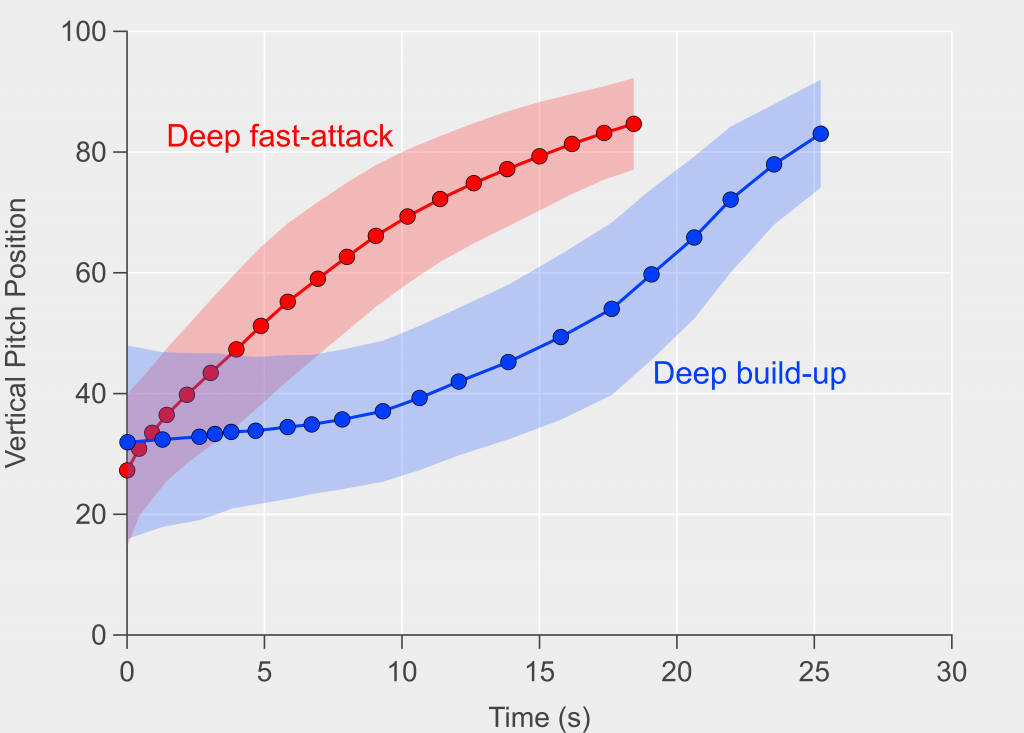
Fast-attacks from deep are characterised by an initial speedy progression towards goal within a team's own half, followed by a steadier advance in the attacking half. This makes sense qualitatively as counter-attacks often see a quick transition in their early stages to properly establish the attacking opportunity. The attack can then be less frenetic as a team seeks to create the best opportunity possible from the situation. Over the past five seasons, the stand out teams as rated by shot volume and expected goals have been various incarnations of Arsenal, Manchester City, Chelsea and Liverpool.
The architects
Player-level metrics can be used to figure out who the crucial architects of a counter-attacking situation are. One method of examining this is how many yards a player's passing progressed the ball during deep fast-attacking possessions. Below I've listed the top 10 players from the 2016/17 season by this metric on a per 90 minute basis, alongside some other metrics for your delectation.

While the focus was often on him kicking people rather than the ball, we see that Granit Xhaka stands alone in terms of ball progression, with Daley Blind a long way behind him in second place. Xhaka's long-range passing skills are well known, so combining this with the most passes per 90 in such situations propels him to the top of pile.
The graphic below illustrates Xhaka's passing during deep fast-attacks, with his penchant for long passes spread all over the midfield zone evident. For comparison, I've included Eden Hazard's passing map as someone who played many important passes that were limited in terms of ball progression as they were typically shorter or lateral passes in the final third.
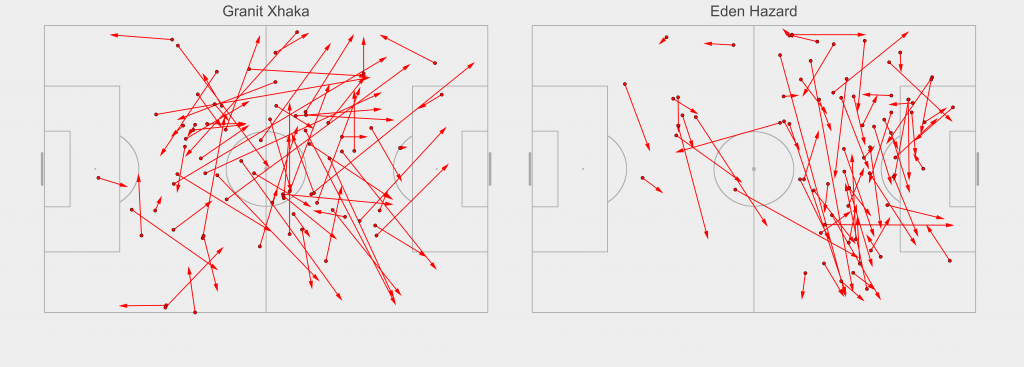
Evidently there is a link between position and ball progression, as players in deeper positions have greater scope to progress the ball as they have more grass in front of them. The likes of Coutinho, Özil and De Bruyne residing so high up the rankings is therefore impressive.
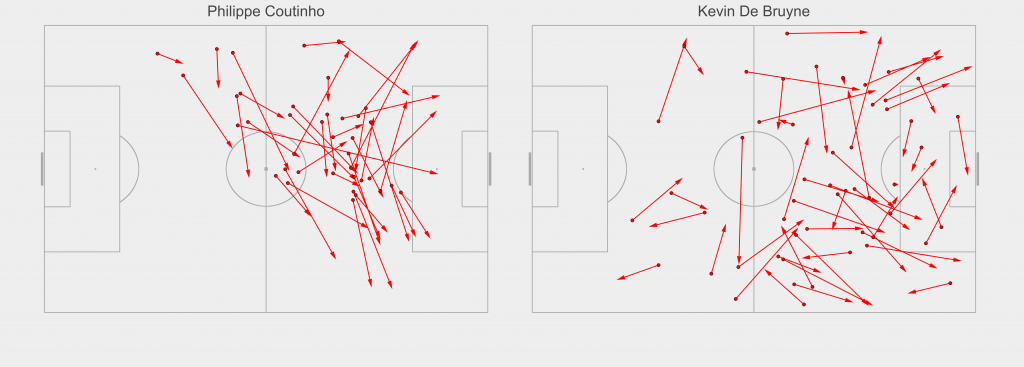
Coutinho's passing chalkboard above illustrates his keen eye for a pass from midfield areas through opposition defensive lines, as does De Bruyne's ability to find teammates inside the penalty area. De Bruyne's contribution actually ranks highest in terms of xG per 90 for the past season.
The finishers
While ball progression through the defensive and midfield zones is important for these fast-attacks from deep, they still require the finishing touches in the final third. There are fewer more frustrating sights in football than watching a counter-attack be botched in its final moments. The graphic below summarises the top players in this crucial aspect by examining their expected goal and assist outputs. Unsurprisingly, Kevin De Bruyne leads the way here and is powered by his exceptional creative passing.
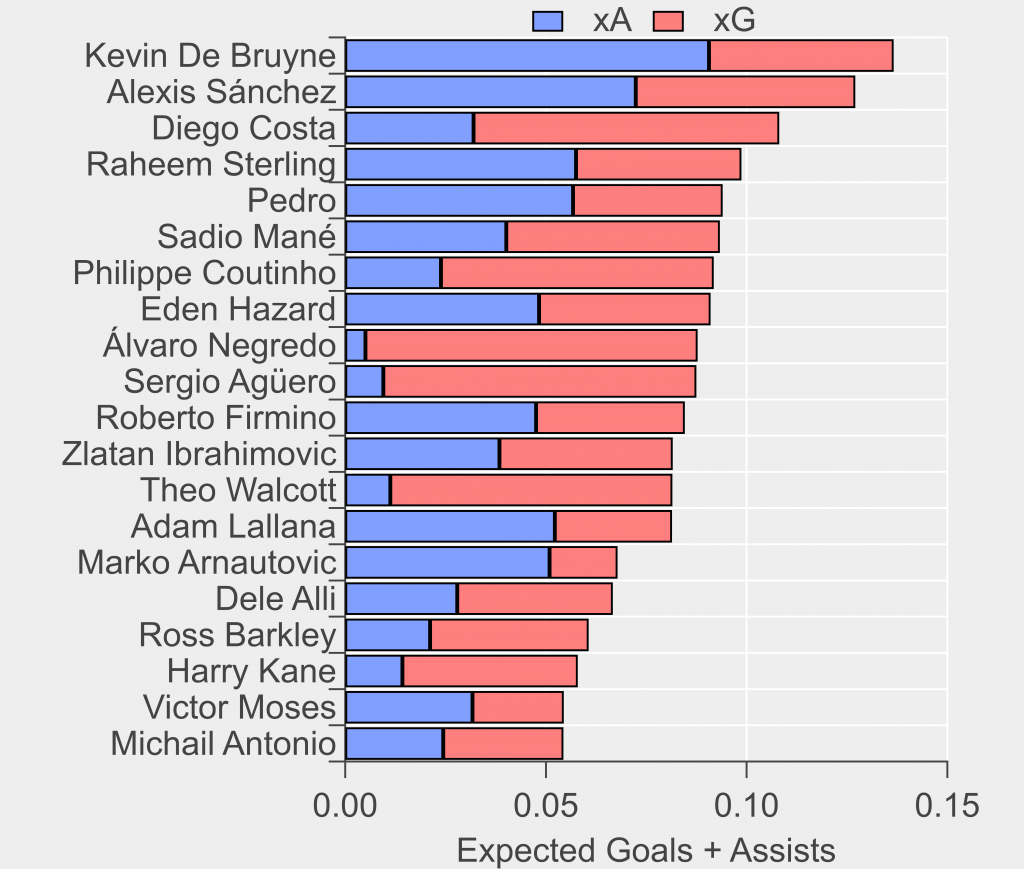
The list is dominated by players from the top-6 clubs, with Negredo the only interloper inside the top-10 ranking. Middlesbrough's minimal attacking output left few scraps of solace for Negredo but at least he did get a few shots away in these high-value situations to alleviate the boredom.
Conclusion
The investigation of tactical and stylistic approaches carried out above merely scratches the surface of possibilities for opposition scouting and player profiling. Being able to identify 'successful' attacking moves opens the door to examining 'failed' possessions, which would allow efficiency to be studied as well as defensive aspects. This is an area rich with promise that I'll examine in the future, along with other styles identified within the same framework.
Identifying Ligue 1's Next Big Breakout Talents #4: Alassane Pléa
Here is Alasanne Pléa’s 2016-17 season:
- Only Edinson Cavani and Memphis Depay this season attempted more open play shots per 90 minutes with at least 900 minutes played in Ligue 1
- Depending on the model being used, Alassane Pléa was somewhere between the top 5-10 in xG per 90 minutes in Ligue 1
- He was the only attacking player on Nice to have not overperformed or even met xG numbers
You can see why Premier League teams in January were considering bidding for Pléa. 24-year-old strikers who produce like that and aren’t already with super expensive clubs don’t exactly grow on trees. Add in that he passes the smell test in terms of athleticism and you’ve got yourself quite the tantalizing forward. Truth be told, I was somewhat skeptical of Alassane Pléa coming into this season. Some of why I was skeptical could be seen here. My main issue was having that nagging feeling that Ben Arfa’s one year renaissance + Germain’s unselfish movements made life for him considerably easier and that those two leaving him would have a knock-on effect. It wouldn’t mean that he’d suddenly fall off the face of the earth, but the most likely scenario would’ve been a slight decrease in his numbers from having to shoulder more of the burden in attack. I also wasn’t quite factoring in the chances of him becoming a much more centralized player, which would hide some of the lack of dynamism he had on-ball.
As it turned out I was wrong, in fact I was dead wrong. Jean Michael Seri had a really good season as a playmaking midfielder, with him and Pléa developing nice chemistry together. Mario Balotelli was fine in the minutes that he and Plea played together, which allowed him to develop even more. You combine that with his natural growth in the striker position--higher volume of shots along with better shot quality--and what you come up with is one of the best forwards in Ligue 1 who if you need him to, can also still play spot duty on the right-hand side.
Last year it could be argued that Alassane Pléa played like a wide forward who could interchange positions and play as a center forward, whereas this season Pléa’s movements and declined on-ball usage much more resembled your typical center forward. This was especially evident in the matches where he wasn’t playing with Balotelli. This isn’t to say his game last year resembled an all action inside forward like say Memphis Depay, but even looking at basic stuff like dribbles or throughballs shows a noticeable change as he was tasked more to create for others:
This year, it’s been different. With so much of the playmaking being tasked to Seri and others, he’s been allowed to be more of a predator, working off the shoulders of center backs and attacking openings with his speed. On the face of it it’s just a simple switch, but it’s one that turned him from a below average shot-maker who had a fairly pedestrian xG per shot of ~12%, to one where he much more resembled a shot-taker.
In a sense, what he’s done this year is somewhat reminiscent of the evolution that Alexandre Lacazette went through between 2014-17; both transitioned into being a centerback’s worst nightmare. Comparing the two today; Lacazette is a better player because he’s just a more fluid attacker in buildup and more adept at getting his own shot off. Particularly the thing that pushes Lacazette over the top in this comparison is his supreme ability to seal off defenders and either spin into open space after receiving the ball or lay it off for a teammate.
But the Lacazette we know today wasn’t the same one at age 24. Sure, he had some of the traits that would turn him into the player that Arsenal are reportedly set to pay a club record fee for, but it would take a couple of more seasons before it led to being a consistently top notch xG contributor. In that sense, one could argue that Pléa at 24 is a better prospect than Lacazette was at that age.
Judging by expected assists or key passes, Alassane Pléa would rank lower on the totem pole for strikers. And I’m not going to say that he’s a brilliant playmaker for a center/wide forward, but I do think he’s fine in the sense that he can make passes that can get his team into advantageous areas on the pitch. On a team with already established playmakers, having a striker who can at least do stuff like this is an asset.
If you had to put me on the spot and ask what is Alassane Pléa’s best spot in the pitch, I would say through the middle, which wasn’t something I would’ve said going into this season. I just think he’s more of an impactful player when he’s concentrating on getting on the end of throughballs and finishing chances. If you structured a team where as a wide forward, all he’d have to do is provide width and make runs, then that’s a different case and he would be a worthwhile gamble. I just think that asking him to be anything resembling high usage with the evidence we’ve seen of him is not getting the best out of him.
So how much will Alassane Pléa cost a club? Well that’s a bit hard to pin down. Technically, Ligue 1 doesn’t allow for release clauses to exist but more clubs are getting past that legality, and reports suggest that Pléa’s got one in the region of €50M. Nice just qualified for the Champions League and combine the funds they’ll get from that along with the probable sale of Seri for big money and the Chinese takeover in ownership, there isn’t the need for Nice to sell. Having said that, what could depreciate his value a bit is that he’s had two major knee injuries over the past two seasons, and he could well be at risk in the future to sustain another one. He had an ACL injury that knocked off four months in 2015-16, and lost the back end of 2016-17 to another knee injury. You don’t have to be a doctor to figure out that repeated trauma to your knees doesn’t exactly scream confidence of avoiding future injuries, but that’s just making an educated guess. Teams that are looking to buy him will get the medical reports and determine whether these two injuries are immediate red flags.
Let’s assume a world where Alassane Pléa has his age 24-29 year uninterrupted by serious knee injuries, what teams would be the best fit for him? One place that could’ve been fascinating was a return to Lyon as a potential replacement for Alexandre Lacazette, though the purchase of Bertrand Traore and the probable asking price from Nice makes the fit considerably more difficult. It’s kind of a shame because the prospects of an attacking core featuring Memphis, Pléa, Traore, and Nabil Fekir as a backup plan for Lacazette’s departure would’ve been grand. For now, we could probably label this as unlikely, even with the scattering of reports that had Bruno Genesio making him a priority this summer.
In England, Southampton could be an intriguing place for him because in many ways he’s the actualized version of what Claude Puel tried to do with Nathan Redmond when he tried to convert him into a secondary striker. The two could work very well together since they’re both capable passers who could interchange positions on the pitch because of their athleticism. He’d also alleviate the worries of what would happen if Gabbiadini got hurt for an extended period because the two aren’t dissimilar in playing style. Again, the worry here isn’t so much in terms of fit as much as whether he’s over their price range, even with them just raking in £122M in Premier League funds in 2016-17. It’d be much of a Southampton move if they instead targeted someone like Yann Karamoh from Caen; who’s only 18 years old, has one year left on his contract, and has shown signs of possibly being a very good forward soon.
There are other places for him to go to in England if it’s not Southampton. Arsenal need forwards and certainly have the money, though the increasing likelihood of Lacazette going there means if they still wanted to get him, it’d probably be more so as a wide forward more so than a striker. Pléa does fit some of the requirements that Arsenal look for: pace, shot location discipline, and not having two cinder-blocks for feet in the passing department, and they could use Pléa in a role not so dissimilar to what Theo Walcott was at his apex. Numerous jokes have been made about West Ham’s continued search for a center forward, and their interest in January probably indicates the search hasn’t ended. On strictly pure need this makes the most sense and West Ham certainly can pay the big money it would probably take to get him, but my level of trust in West Ham putting together a cohesive midfield to accentuate the best parts of Pléa's game isn't exactly high.
Alassane Pléa has turned himself into a very solid player in Ligue 1 despite being a late bloomer of sorts, having just completed only his third season of over 1000 league minutes at age 24. He’s increased his shot load from last year and simultaneously improved his shot location as well. His ability to operate in tight areas has improved, his passing is fine, and combined with his ample athleticism makes him a good player that's embarking on the prime years of his career. We don’t know if the knee injury that ended his season took something out of him, and if anything, that’s the biggest worry. He's certainly worth monitoring through next season, and with health, at 25 could still represent a good purchase. Once again, we find Ligue 1 to be housing high quality talent and the path from France to Europe's bigger clubs is well trodden. Pléa could well be one of the next guys to make the switch.
_________________________________
This is part four of a series, check out the first three parts:
#2 Thomas Lemar
